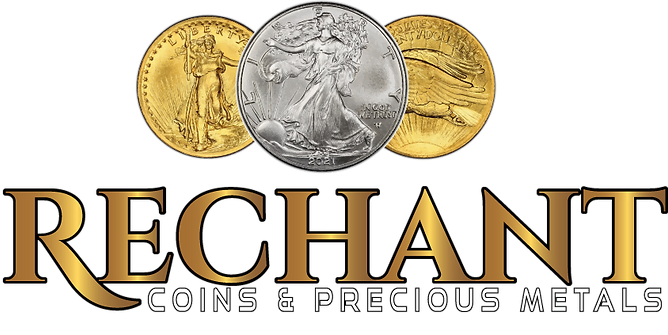Gold Bullion Purity Explained Guide
Gold bullion represents not only an iconic investment but also a significant measure of financial stability. Whether it's a gold bar, rare coin, or piece of jewelry, the level of purity profoundly impacts its value and desirability.
At Rechant Coins & Precious Metals, located in West Palm Beach and proudly serving South Florida since 1975, we’ve earned a reputation for helping collectors and investors navigate the complexities of gold purity.
In this guide, we’ll outline everything you need to understand the importance of gold fineness, the karat system, and identifying hallmark stamps, ensuring each transaction—buying or selling—is informed and accurate.
With nearly 50 years of expertise, our goal is to share unique knowledge, empowering you to confidently evaluate and invest in gold bullion.
Click here to learn more about: for sale now
Gold Bullion Purity Explained Guide
Every piece of gold bullion, whether an ornate engagement ring or a sleek investment bar, owes its value to its level of purity. The concept of purity refers to the proportion of pure gold present in a specific gold item, typically expressed in karats or fineness.
At Rechant Coins & Precious Metals, we’ve seen how purity levels directly impact decisions made by seasoned numismatists and new investors alike. For example:
- 24-karat gold (999 fineness) is considered the purest form of gold (99.99%) and is highly favored for its intrinsic value.
- 18-karat gold, comprised of 75% gold and 25% alloy metals, offers enhanced durability but reduced gold content.
- Lower-karat pieces, such as 14-karat gold, blend of 58% gold with other metals (42%) to achieve affordability and sturdiness.
Recognizing hallmark stamps such as 999 fine or 22-karat ensures buyers know the value of the gold they’re investing in. Our experience as a trusted South Florida coin dealer underscores the importance of working with experts, like our team, to avoid low-quality or misrepresented gold items.
Understanding Gold Purity Levels
The measurement of gold purity has a rich history spanning centuries. Systems like the karat system, often used in jewelry, and fineness marks, prevalent in gold bars and investment bullion, provide consistent benchmarks for purity. These systems are essential for assessing gold’s value and authenticity.
The Karat System
The karat system divides gold into 24 parts, with each part representing a fraction of the metal’s purity. For instance:
“24-karat gold equals 100% purity,” while “18 karats” contain 75% pure gold and 25% added alloys like copper or silver.
This division allows for easy comparison across various gold products, like bullion coins or gold jewelry, ensuring transparency in every transaction.
The Fineness System
The fineness system measures gold in parts per thousand (ppt), offering a precise method for evaluating gold bullion. For example:
- 999 fine gold signifies nearly 100% pure gold.
- 916 fineness, also known as 22 karat, describes a mix of 96% gold and 4% other metals.
Today, organizations like the London Bullion Market Association, Royal Mint, and Perth Mint uphold global standards, ensuring consistent quality and trustworthiness across all types of gold.
Purity’s Impact on Price and Use
In terms of pricing, the higher the purity, the greater the price of gold for a given weight. For this reason, collectors and investors often prioritize fine gold (999) for its superior resale value. Yet, gold alloys, such as yellow gold or rose gold, crafted with copper and other metals, remain popular thanks to their durability and affordability.
The purity of gold impacts not only its cost but also its intended use—whether as an investment piece or stylish addition to a collection.
At Rechant Coins, our expertise ensures you receive precise assessments of gold alloys, bullion, or gold coins, helping you find the perfect balance between price and quality.
Discover the Intricacies of Gold Purity and Value
Gold is often misunderstood, but whether you're investing in bullion or selecting gold jewelry, its purity level plays a significant role in its value and practicality. Dive into this section to learn why fineness and karat measurements matter, how they impact pricing, and tips to enhance your buying decisions.
How Fineness Affects Value
The fineness of gold directly determines its market value, making it a cornerstone for investors and collectors.
Measured in parts per thousand, this metric indicates the proportion of pure gold within a gold item.
For instance, .999 fineness denotes nearly 100% pure gold, often referred to as fine gold. A prime example is the Canadian Gold Maple Leaf, a widely sought-after bullion coin endorsed by the London Bullion Market Association for its high purity.
Achieving absolute purity, such as 999 gold, is extremely rare.
Most investment-grade gold bullion coins and bars offer fineness levels ranging from 999 to 24 karat, providing exceptional value for buyers. On the other hand, gold items with lower purity levels, such as 14 karat jewelry (58% gold), balance affordability with increased durability.
This makes them popular in everyday wear, such as engagement rings, and ensures greater resistance to wear and tear.
When purchasing gold bars, coins, or gold jewelry, buyers should consider fineness benchmarks, such as 22 karat gold (96% pure). Gold's intrinsic value rises with its purity level, but alloying it with other metals like copper or silver enhances its robustness for practical uses.
Always verify the hallmark and certification from trusted sources like the Royal Mint or Perth Mint to ensure the product’s authenticity and quality.
The Role Of Karat In Gold
Gold is often classified using the karat system, which measures its purity based on 24 parts.
This system represents the proportion of pure gold in an alloy.
For example, 24-karat gold is 100% pure, while 18 karat gold consists of 18 parts gold and six parts of other metals, such as silver or copper.
Karat Levels and Their Usability
Higher karat levels, such as 22 karat gold, are softer and ideal for investment gold. Coins like the South African Krugerrand, at 22 karats, balance substantial gold content with a small percentage of alloyed metals for slight durability improvements.
Meanwhile, 14 karat gold, with its 58% gold content, dominates gold jewelry markets for its affordability and practical wearability. This balance of purity and strength makes it a popular material for creating pieces like necklaces, bracelets, and earrings.
Impacts of Karat on Gold Value
The value of gold increases with higher karat levels, yet lower-karat items remain popular due to their reduced price points and robust composition.
For example, 14-karat gold, common in decorative items, contains 58% gold and is often alloyed with metals like zinc or copper.
While it doesn’t hold the same intrinsic value as 24-karat gold, its accessibility appeals to a broader audience.
To avoid overpaying for gold items, buyers should always cross-check the karat mark with the seller’s claims.
Reputable organizations like the London Bullion Market Association and national mints, including the United States Mint, remain benchmarks for quality assurance. Whether you’re adding to your collection or buying responsibly for investment purposes, understanding the role of karat ensures a reliable purchase every time.
| Gold Purity Measurement | Examples and Applications |
|---|---|
| Fineness (e. g. , 999) | Canadian Gold Maple Leaf with nearly 100% purity |
| Karat System (e. g. , 22 karat) | South African Krugerrand with 22 karats |
| Lower Purity (e. g. , 14 karat) | Common in gold jewelry like necklaces and earrings |
| Alloyed Gold | Gold mixed with copper or silver for durability |
The Intriguing World of Gold Purity: What Coin Collectors Need to Know
Gold purity fascinates collectors and investors alike, offering a blend of history, artistry, and intrinsic value. For those exploring precious metals, understanding gold purity is essential to making informed decisions.
This section highlights two critical aspects: why pure gold is too soft for practical use and how gold alloys overcome such limitations to become ideal choices for investment gold, jewelry, and industrial applications.
Whether you're evaluating a gold coin, a collectible gold bar, or an engagement ring, knowing these nuances ensures you're prepared to make the best choices.
Why Pure Gold Is Too Soft
Pure gold’s softness often comes as a surprise to those familiar with this precious metal’s enduring allure.
With 24-karat gold—often referred to as the purest form of gold—the atomic structure of the metal results in exceptional ductility. This quality, while enhancing its malleability, makes it prone to dents, bends, and surface scratches.
A gold purity of 999 (parts per thousand) ensures its brilliance but limits its durability, particularly in handling gold bullion, ornaments, or coins.
The Impact of Handling Pure Gold
Handling pure gold bars or coins without precautions can permanently mar their surface. Collectors of fine gold items, such as a 24-karat Royal Mint gold coin, often use protective casings or gloves to preserve their value.
The price of gold may decrease if visible damage impacts its aesthetic or collectible appeal.
Alloying to Enhance Durability
To address these limitations, pure gold is alloyed with other metals, such as silver, copper, or nickel.
This process improves the strength of gold without sacrificing its intrinsic brilliance.
For example, 18-karat gold—composed of 75% actual gold—offers a balanced combination of beauty and resilience, ideal for gold jewelry, coins, and other valued pieces.
Common Gold Alloys Explained
The concept of gold alloys revolutionized the usability of pure gold. By blending gold with other elements, the resulting composition offers enhanced versatility across industries.
Collectors and investors often encounter these alloys in various forms, each tailored to specific applications.
Gold Alloys in Coins
In the realm of gold coins, 22-karat alloys (92% pure gold) remain a favorite. Examples include the American Gold Eagle and South African Krugerrand.
Their durability ensures resilience against handling and transportation while retaining most of the gold’s intrinsic value.
International mints such as the Royal Mint and Perth Mint rely on these alloys for their flagship coins.
Gold Alloys in Jewelry
Jewelry enthusiasts appreciate the range of hues offered by alloys.
For instance, yellow gold combines gold and silver, while rose gold gains its blush tones from higher copper content. White gold—commonly found in engagement rings—incorporates nickel or palladium for a sleek, modern aesthetic.
Industrial Applications
The unique chemical properties of gold alloys also extend into industries like electronics.
The ability to resist corrosion makes these metals invaluable for connectors and components. Depending on the percentage of gold within an alloy, its usability can range from decorative to functional purposes.
“The versatility of gold alloys ensures their relevance across a spectrum of uses—from investment bars to intricate jewelry pieces.”
By exploring the characteristics of different types of gold, buyers and collectors can make smarter decisions aligned with their goals, whether investing in a gold bar, purchasing jewelry, or acquiring collector coins from local shops.
Key Facts About Gold Purity and Alloys
- Pure gold, at 24 karats, is highly malleable and prone to damage, making it unsuitable for practical use without alloying.
- Common gold alloys, such as 18-karat gold (75% pure gold), strike a balance between beauty and durability for jewelry and coins.
- Gold alloys like 22 karat are favored for coins such as the American Gold Eagle and South African Krugerrand due to their resilience.
- Industries like electronics utilize gold alloys for their corrosion resistance and functional versatility.
Gold Hallmarks and Purity: A Guide for Collectors and Investors
Gold has long been cherished for its beauty and value, making it essential to ensure authenticity and quality when dealing with any gold item. Hallmarks and purity standards provide a transparent system for evaluating gold's authenticity, origin, and intrinsic worth.
As experienced coin dealers, we’ll explore the importance of hallmarks in guaranteeing a gold item’s value and how purity measures differ for investment bars and collectible coins.
Whether you're a seasoned investor or new to the world of precious metals, this practical guide will provide the insights you need to buy, sell, or appraise gold with confidence.
Hallmarks and Their Importance
When it comes to gold, the hallmark is more than just a stamp; it’s the benchmark for authenticity and quality.
These tiny markings signify the gold content, origin, and compliance with established standards. Each hallmark offers unique details, including the fineness or karat of the gold, the country of origin, and the assay office responsible for testing the metal.
Buyers can rest assured knowing that hallmarks protect them from counterfeits and inflated claims.
The Role of Hallmarks in Determining Purity
Gold purity is reflected through hallmarks, which indicate the proportion of pure gold in a piece. For instance, a hallmark reading 999 represents near-pure gold, also known as fine gold.
It's worth noting that pure gold, or 24-karat gold, is too soft for most practical uses and is alloyed with other metals for durability.
By examining these markings, buyers gain clarity on the percentage of gold to other materials, ensuring they make informed purchases.
How Hallmarks Safeguard Buyers
Whether you're purchasing an engagement ring or investing in a gold bar, hallmarks provide a transparent measure of quality.
Reputable institutions such as the Royal Mint in the United Kingdom or the London Bullion Market Association adhere to stringent hallmarking standards. This ensures consistent quality across products, safeguarding your investment and building trust in every transaction.
“Gold that is not hallmarked leaves buyers vulnerable to counterfeit pieces, misrepresented purity, and financial loss. ”
For those in areas like Palm Beach, Jupiter, and Boca Raton, our team at Rechant Coins & Precious Metals is here to help you evaluate the hallmarks and determine the true quality of your gold items.
Gold Purity in Coins and Bars
Gold purity standards vary significantly between collectible coins and investment bars, serving different purposes for buyers.
While coins often strike a balance between durability and historical significance, bars prioritize maximum intrinsic value. These differences influence how gold is used by collectors and investors alike.
Purity Levels in Coins
Gold coins, like the renowned 22-karat South African Krugerrand, blend durability with aesthetic appeal.
With a fineness of 92%, the remaining percentage consists of metals like copper for added strength.
This makes coins practical for handling and storage, while still retaining significant gold content.
Collectors often choose coins for their craftsmanship and connection to historical events, with limited mintages driving their collectible value.
Investment Bars and Their Focus on Fineness
Gold bars, such as those refined by the Perth Mint or United States-based mints, typically feature 99% fineness or higher. This ensures their suitability for investment purposes, as bars are primarily valued for their pure gold content.
The price of gold bars remains closely aligned with market rates, making them an excellent choice for those looking to invest in gold for financial security.
“When selecting between coins and bars, always consider your goals—whether historical value excites you or maximizing gold content is your priority. ”
For investors in South Florida, our team at Rechant Coins & Precious Metals provides expert guidance on evaluating gold fineness and choosing the right form of gold for your portfolio or collection.
| Gold Coins | Gold Bars |
|---|---|
| Blend durability with historical significance | Prioritize maximum intrinsic value |
| Typically 22 karat, like the American Gold Eagle | Typically 92% fineness or higher |
| Valued for craftsmanship and limited mintages | Closely aligned with market rates |
Your Guide to Buying Investment Gold with Confidence
When considering investment gold, the key to success lies in identifying authenticity, understanding gold purity levels, and selecting trustworthy dealers. Gold is the purest form of precious metal available for investment, and verifying its quality can protect your assets.
From examining hallmarks to evaluating pricing transparency, this section offers actionable tips for securing genuine gold bullion or gold jewelry pieces.
Learn how to assess gold fineness, measure gold purity accurately using tools, and spot signs of quality that ensure your investment will stand the test of time.
Read on for practical advice that can make purchasing gold items an informed and secure process.
Tips For Buying Investment Gold
Securing the right gold investment requires distinct attention to authenticity, gold purity, and reputable sources. Investment gold frequently includes forms like gold bars, gold coins, and even high-quality gold jewelry.
Whether you are evaluating 24-karat gold or alloyed 18-karat pieces, understanding the proportion of pure gold helps determine the value of gold items. Checking for reputable hallmarks such as those from the Royal Mint or London Bullion Market Association establishes legitimacy.
Spotting Hallmarks and Checking Purity
Gold's purity directly impacts its value, and markings such as 999 or 22-karat indicate its fineness.
Always look for hallmarked gold pieces to ensure consistency and avoid counterfeit risks.
For instance, gold bars with 999 markings signify almost pure gold, while gold coins from mints like Perth Mint or United States mints carry exceptional credibility.
Testing gold purity using electronic testers or density kits can confirm its authenticity before purchase.
Pro Tip: Always cross-check the hallmark's legitimacy against the mint’s official records to verify accuracy.
Evaluating Reputable Dealers and Pricing Transparency
When buying gold for investment purposes, reliable dealers provide both transparency and fair pricing. Reputable dealerships typically offer detailed specifications for the gold pieces they sell, whether it is investment bars, pure gold bars, or unique forms of gold like rose gold or yellow gold.
Avoid excessive premiums by comparing prices across several dealers and referencing the prevailing price of gold in the market.
Pro Tip: Dealers affiliated with trusted organizations like the American Numismatic Association or the Better Business Bureau are more likely to offer authentic options.
Practical Insights for Smart Purchases
Weight, dimensions, and purity level are critical elements when evaluating gold items. For example, gold alloys in 18-karat gold contain parts of other metals, making them less valuable compared to 24-karat gold.
The higher the purity—such as 999 gold or 24 karats—the softer and more ductile the gold becomes, which is why pure gold is often alloyed with other metals for durability.
Gold testing is another essential step.
Even simple kits for measuring gold purity can help identify counterfeit pieces while ensuring the investment matches advertised fineness levels.
Ensuring Long-term Value in Investment Gold
Gold bullion and gold coins remain popular investment options because of their long-term value and liquidity. Monitor the prevailing price of gold and prioritize pieces with high gold fineness to maximize return potential.
Remember that 22-karat or 24-karat gold coins from the Royal Mint or Perth Mint can offer timeless investment appeal. Gold jewelry may also serve as an alternative, but it’s crucial to understand how alloyed metals like silver or copper impact gold’s overall value.
Buying Investment Gold
- Gold purity markings like 999 or 22 karat indicate the fineness and value of the gold.
- Reputable hallmarks, such as those from the Royal Mint or Perth Mint, help verify authenticity.
- Testing gold purity with electronic testers or density kits ensures the investment matches the advertised quality.
- Dealers affiliated with organizations like the American Numismatic Association provide more reliable options.
Gold Bullion Investment Strategy Tips
Best Gold Bullion Dealers 2025










